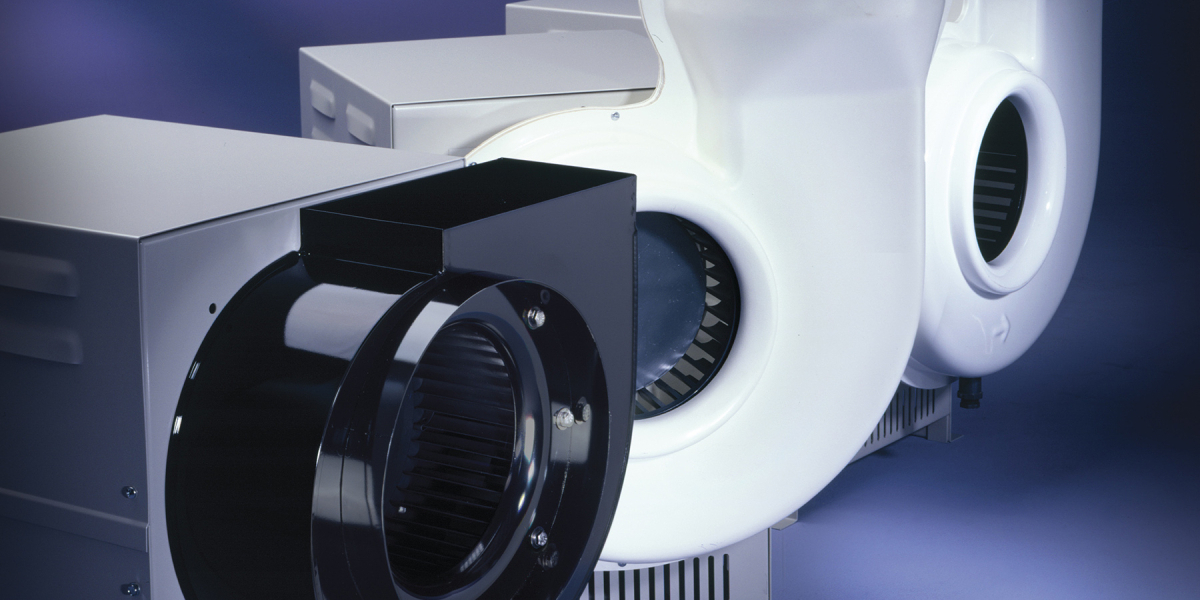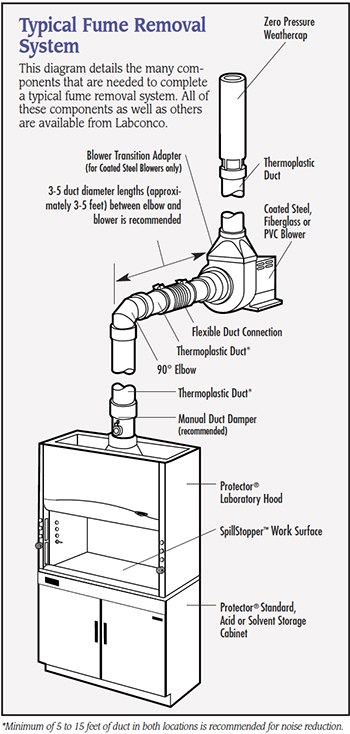4 Reasons You Should Use a Remote Blower Instead of a Built-In Blower

Fume Hood Blowers: An Exhausting Subject
 A blower, or exhaust fan, is a very important part of a fume hood system. It is the component that moves air through the fume hood. Many people are under the impression that all fume hoods come with a built-in (or integral) blower.
A blower, or exhaust fan, is a very important part of a fume hood system. It is the component that moves air through the fume hood. Many people are under the impression that all fume hoods come with a built-in (or integral) blower.
A built-in blower is mounted right above the fume hood. In that scenario, the blower pushes the contaminated air out from the hood, through the ductwork, to the outside.
In most labs, however, a remote blower is used, as shown in the Typical Fume Removal System graphic to the right. This means the blower is located remotely from the fume hood, on the rooftop typically, and pulls the air all the way through the duct work to be exhausted outside.
There are many things to consider when choosing a blower. Here are four reasons why you should always use a remote blower over an integral blower.
1. Fume hoods with built-in blowers to duct outside do not meet ANSI Z9.5!
If your specification requires compliance with ANSI Z9.5, you must use a remote blower. Section 5.4.4 of ANSI/AIHA Z9.5-2012 clearly states:
Laboratory exhaust fans shall be located as follows:
-
Physically outside the laboratory building and preferably on the highest-level roof of the building served. This is the preferred location since it generally minimizes risk of personnel coming into contact with the exhaust airflow.
- In a roof penthouse or a mechanical equipment room on the roof that is always maintained at a negative static pressure with respect to the rest of the facility, and provides direct fan discharge into the exhaust stack(s).
So if your blower is mounted on top of your fume hood, it won’t be “physically outside of the laboratory building” and it won’t be located in a “mechanical equipment room that is always maintained at a negative static pressure with respect to the rest of the facility.”
2. Remote blowers are safer
A remote blower is a failsafe, meaning if there is a leak in the duct work at any point, the duct is kept under negative pressure. In the event of a leak, clean air will be pulled through that leak and exhausted out, instead of pushing contaminated air out of that leak (as a built-in blower would).
If you have an application with hazardous chemicals or a building where your fume hood duct run goes through multiple occupied floors, a remote blower should be used.
 3. Built-in blowers are not a one-size-fits-all
3. Built-in blowers are not a one-size-fits-all
Every blower has a blower curve chart that shows under what circumstances the blower can operate properly. This includes the static pressure and CFM requirements (shown in the figure to the left).
The mechanical system has to fit the integral blower. So even though you have a duct run that is only 10 feet long, that does not mean it will work well.
It will most likely require a manual control damper to add resistance to the line. Blowers require a certain amount of resistance, or static pressure, to work effectively.
Think of it like using a blender to make a smoothie, if the ice doesn’t fall to the blades, the motor goes too fast and you can sometimes smell the motor burning up since it does not have any resistance to work against. It’s the same concept for a blower motor – it requires resistance to work properly.
4. Built-in blowers are louder
Noise issues can arise for a couple different reasons, but there is no doubt, when the blower is sitting right on top of the fume hood, it will be louder than if it were mounted on the rooftop. If there is noise sensitivity, for example in a classroom setting, it’s highly recommended to have a remote blower so the teacher doesn’t have to speak over the blower motor while teaching.
The air turbulence itself can create noise as well.
Things that contribute to the air noise are the duct material (metal is loudest), and the duct run design (the more bends, the louder). So it is always recommended to put 3 to 5 duct diameters of straight duct before and after each bend, and off the fume hood exhaust collar, in order to straighten the air colun and reduce the turbulence.
Those are the four reasons a remote blower should be used over a built-in blower. Obviously there are scenarios where a built-in blower must be used, but one should always consider a remote blower first, then move from there.
I would only recommend using a built-in blower if you absolutely cannot use a remote blower.
And now here's a helpful graphic explaining positive (+) and negative (-) pressure as it relates to blower location and safety. Enjoy.
| chevron_left | How long will it take to freeze dry my samples? | Articles | Water World – Quenching Your Thirst For Purified Water | chevron_right |







